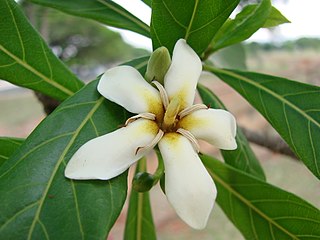
Genipa americana is a species of trees in the family Rubiaceae. It is native to the tropical forests of North and South America, as well as the Caribbean.

Terminalia catappa is a large tropical tree in the leadwood tree family, Combretaceae, native to Asia, Australia, the Pacific, Madagascar and Seychelles. Common names in English include country almond, Indian almond, Malabar almond, sea almond, tropical almond, beach almond and false kamani.
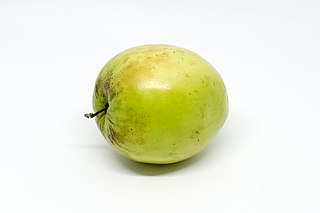
Ziziphus mauritiana, also known as Indian jujube, Indian plum, Chinese date, Chinese apple, ber and dunks is a tropical fruit tree species belonging to the family Rhamnaceae. It is often confused with the closely related Chinese jujube, but whereas Z. jujuba prefers temperate climates, Z. mauritiana is tropical to subtropical.

Olea capensis, the black ironwood, is an African tree species in the olive family Oleaceae. It is widespread in sub-Saharan Africa: from the east in Somalia, Ethiopia and Sudan, south to the tip of South Africa, and west to Cameroon, Sierra Leone and the islands of the Gulf of Guinea, as well as Madagascar and the Comoros. It occurs in bush, littoral scrub and evergreen forest.

Lonicera caerulea, also known by its common names blue honeysuckle, sweetberry honeysuckle, fly honeysuckle, blue-berried honeysuckle, or the honeyberry, is a non-climbing honeysuckle native throughout the cool temperate Northern Hemisphere regions of North America, Europe, and Asia.

Pleiogynium timoriense, commonly known as the Burdekin plum, sweet plum, tulip plum, or in the Djabugay language guybalum, is a medium-sized fruit-bearing tree in the cashew and mango family Anacardiaceae native to Malesia, Australia and the Pacific Islands.

Oemleria cerasiformis, a shrub commonly known as osoberry or Indian plum, is the sole species in genus Oemleria.

Lecythis pisonis, the cream nut or monkey pot, is a tropical tree in the Brazil nut family Lecythidaceae. It is known in its native tropical America as sapucaia or castanha-de-sapucaia. The fruit is shaped like a cooking pot and contains edible seeds.
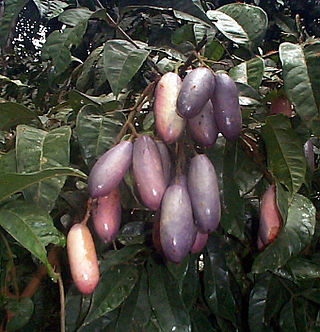
Dacryodes edulis is a fruit tree in the Burseraceae family native to Africa. Its various regional names include safou, messa, plum (Cameroon), atanga, ube, elumi (Nigeria), African pear, bush pear, African plum, nsafu, bush butter tree, or butterfruit.
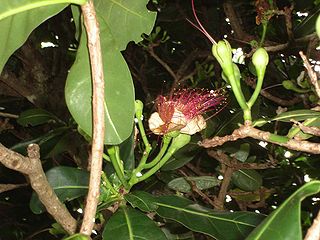
Barringtonia is a genus of flowering plants in the family Lecythidaceae first described as a genus with this name in 1775. It is native to Africa, southern Asia, Australia, and various islands of the Pacific and Indian Oceans. The genus name commemorates Daines Barrington.

Inocarpus fagifer, commonly known as the Tahitian chestnut or Polynesian chestnut, is a species of flowering plant in the subfamily Faboideae of the legume family, Fabaceae. The tree has a wide range in the tropics of the south-west Pacific and south-east Asian regions, and a history of traditional use by the peoples of Polynesia and Melanesia. It is the only edible and culturally important member of the genus Inocarpus.

Cycas rumphii, commonly known as queen sago or the queen sago palm, is a dioecious gymnosperm, a species of cycad in the genus Cycas native to Indonesia, New Guinea and Christmas Island. Although palm-like in appearance, it is not a palm.

Homalanthus nutans, known locally as the mamala tree, is a species of plant in the family Euphorbiaceae. In Australia it is known as the bleeding heart and the Queensland poplar.

Diospyros dichrophylla (Gand.) De Winter is a Southern African tree belonging to the ebony family of Ebenaceae and closely related to the Persimmon.
Barringtonia sarawakensis is a plant in the family Lecythidaceae.

Eugenia myrcianthes or ubajay is a species of plant in the family Myrtaceae found in Argentina, Bolivia, Brazil, Paraguay and Uruguay.
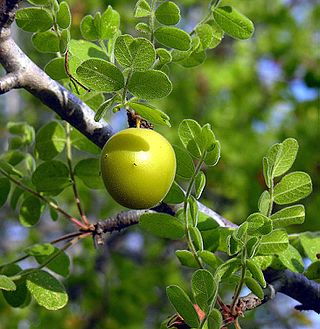
Cyrtocarpa edulis is a species of perennial sarcocaulescent tree commonly known as the Cimarrón plum or Cape wild-plum. It is in the genus Cyrtocarpa, and is endemic to Baja California Sur. This plant is characterized by fleshy stems, twisted branches and an edible drupe.
Bactrocera passiflorae, the Fijian fruit fly, is a species of fly in the family Tephritidae in the insect order Diptera. It is native to several tropical and subtropical islands in the Pacific Ocean and is a pest of fruit crops.

Canarium indicum, known as galip nut, is a mainly dioecious tree native in eastern Melanesia. It is usually found in rainforests, secondary forests, old garden areas, around villages and settlements. It is also used as a shade tree, as a windbreak and in agroforestry. Canarium is important in the world food system as it can be used as a food and timber source, in traditional medicine, intercropping and agroforestry.
Gambeya africana is a medium sized tree within the Sapotaceae family. It is sometimes known as the African Star Apple along with the closely related Gambeya albida. Both species have similar leaf indumentum and are widespread in the Lower and Upper Guinea forest mosaic.

















